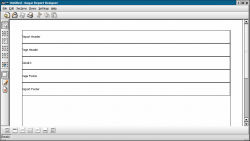Archive:Kugar: Difference between revisions
Appearance
m Prepare for Kugar Tutorials |
No edit summary |
||
| Line 6: | Line 6: | ||
'''Kugar''' uses XML to merge your data with your template, creating reports that can be embedded in your documents. It is also possible to embed the generator within custom application. | '''Kugar''' uses XML to merge your data with your template, creating reports that can be embedded in your documents. It is also possible to embed the generator within custom application. | ||
Kugar is discontinued in the KOffice2 series and will be replaced by Kexi and its report generator in the future. | |||
Revision as of 11:44, 26 April 2009
Template:I18n/Language Navigation Bar
 |
Generate business quality reports from your data |
Kugar uses XML to merge your data with your template, creating reports that can be embedded in your documents. It is also possible to embed the generator within custom application.
Kugar is discontinued in the KOffice2 series and will be replaced by Kexi and its report generator in the future.
